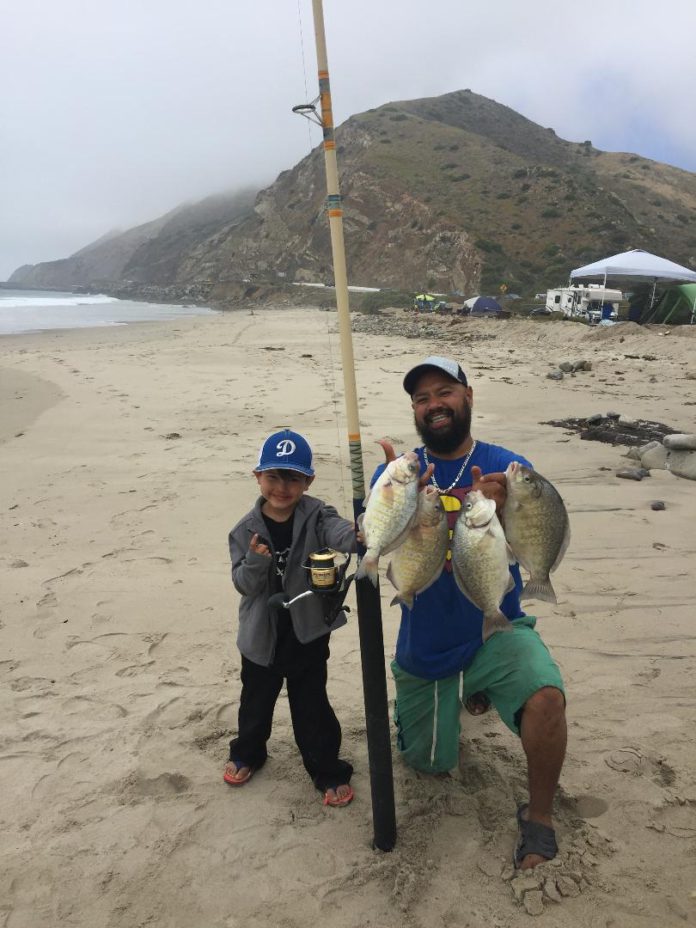BY GUNDY GUNDERSON
On a clear, brisk morning, I make the last of the steps down to the beach and stop to survey the scene. The water is glassy and calm, a mild offshore pushes in the smells of the coastal scrub and the surf barrels cleanly onto the beach. A side-armed cast puts the Carolina rigged grub in the dark green water of the surf-formed trench. I flip the bail and wind tight to the sinker. I begin to drag the rig in toward the beach and bang! A fish inhales the grub.
I wind tight and lay back with my rod. The light tip arcs sharply toward the surging surf. The barrel of the spinning reel turns as the fish takes two short bursts of line. With constant pressure, the game adversary begins to yield. On a small breaker, the tired fish is dragged up on to the wet slope of the sand beach. The morning glow colors the fish a rich barred gold. I land her, admire her, then release her into the shallow remains of the last breaker. The next cast produces another quality fish and the next, yet another. The barred perch are biting well this morning.
Barred surfperch are one of the most accessible and most caught gamefish on the Southern California coast. They can be found from Morro Bay to northern Baja. Find them on the open beaches inhabiting and feeding out of trenches and holes in the surf line. They will also orient around structure like reefs, scattered rocks, pier pilings and jetty rock.
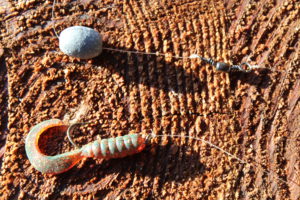
The barred surfperch can provide fast action on light tackle for both expert and novice surf angler. Although these aggressive surf line feeders will eat a variety of live and cut baits my favorite way to take them is by using small plastic grubs.
Barred surfperch are most often found in the turbulent waters of the breakers. The wave action on the beach dislodges food and small prey, drawing the perch into thin water to feed. With keen eyesight, perch can spot these meals through the sand, air bubbles and foam kicked up by the breaking waves. The fish instinctively strike whatever moves in this feeding zone. For this reason, a small grub with its whirling tail action can be deadly on these aggressive surf zone predators.
The grub is best fished on a Carolina rig. In light surf, start with a ¼-ounce egg sinker, in heavier surf, a ½ – or ¾ –ounce sinker. With the sinker on the main line, use a bead, swivel and 16 to 18 inches of leader, either mono or fluorocarbon. Under most conditions, an inch-and-a-half grub, a #6 baitholder hook and 6-pound test leader are ideal. When big perch are present or you are fishing reef, jetty rock or pier pilings, go to a three-inch grub on a #4 baitholder hook on 8-pound test.
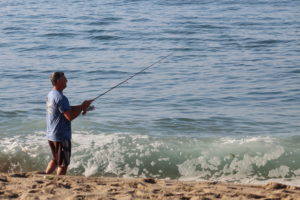
Although surf fishing is more commonly associated with long rods, heavy line and big sinkers, grub fishing for surfperch is a light tackle endeavor. Most of the targeted quarry is found in the more turbulent shallow areas of the surf zone which is essentially where the surf breaks. The majority of barred perch will feed actively in the wake of a pounding wave or in the “trench” formed by the breaking surf. Food and prey are dislodged by the surf action and the opportunistic predators are quick to take advantage. Long casts with heavy sinkers are not necessary.
Light rods and small spinning reels are ideal for getting your small plastic bait to the fish. In addition, light tackle makes for excellent sport when tangling with perch that commonly reach up to 3 pounds with the occasional kicker pushing the 4-pound mark. The occasional halibut on the grub will also test your light-tackle skills.
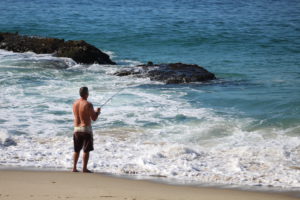
I prefer a seven- to nine-foot, light action rod and a small spinning reel loaded with 6-pound test. The longer rod is useful in putting the rod tip up high, allowing you to work your grub more effectively in the surf zone. A light action is sensitive to the small sinker and the perch’s often subtle take. The rod is also forgiving in heavier surf or surge once a fish is hooked. The spinning reel should have a smooth drag and fresh line. As for grub colors, I like browns and reds. Darker colors tend to show better in the din of the surf line. For consistently good action, choose a quality grub. Some better colors are motor/oil, root beer, clear red/flake, motor oil/gold flake and watermelon /red flake.
It is important to string the grub on straight and make sure the hook emerges at a spot that retains the original grub shape. If the grub is crooked and unbalanced, the bait will not swim right. If you lay the grub against the hook, you can see where in the plastic the hook should emerge. Prick the plastic at this spot centered on the top of the grub. Now when you string the grub on you know where to come out of the grub. Most grub manufacturers suggest rigging the grub with the tail turned up. Finally, test the grub. Pull the lure through the clear, shallow water and make sure the tail is twirling. If it doesn’t look right, it probably won’t get bit.
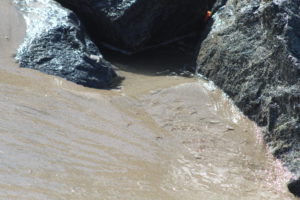
The standard grub presentation goes something like this. Wait until a wave is cresting for a beach break. Cast beyond the break into the smooth water on the backside. This will allow your rig to settle quickly to the bottom without the tumult of the surf break. Immediately put the reel in gear then come tight to the sinker. With the rod tip up, lift the sinker slightly and wind the rig in slowly, maintaining contact with the bottom. Prepare for a strike at any moment. A high rod tip works in two ways. One, it is the best way to animate a grub, much like dragging a plastic worm. Lift, wind, drop. Secondly, a high rod tip and a sharp angle of entry will minimize the effect of the breakers pushing your rig up onto the beach. Less line is in contact with the water. Drag the rig up into the shallowest water as the bite can come in 6 inches of water. When the grub is shallow, you can drop the rod tip to continue the proper angle of the grub’s swim. Upon a take, wind the grub tight until the rod loads up, then set the hook. If you swing before the line is tight you will miss some strikes.
Timing your cast with the wave action will put your bait in the strike zone longer, allowing more time for a perch to find it. Pay close attention as to where you are getting bit as this zone will yield strikes consistently.
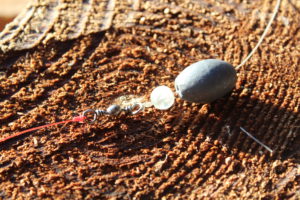
The feeding habits of barred surf perch are always tide oriented. The fish will move up onto the beaches with the incoming tide. They will often feed at different points on the beach depending on the height of the tide. They may drop outside the trench into deeper depressions at lower tides than occupy the trench and feed up on the sloped beach at higher tides.
One of the first investments a surf fisherman should make is in a good tide log. Tide is one of the major forces that influences tidal and inshore waters. The entire inshore, aquatic food chain, from minute organisms to top-line predators, responds to opportunities created by the massive movement of water during these periods of tide changes. Strong tides usually provide more robust fishing than weaker tides.
Predator fish behavior is often dictated by tidal movement because baitfish, sand crabs, worms, crustaceans and other prey are also active during these tide movements and will expose themselves to predation. In bays and estuaries, fish behavior is heavily influenced primarily by the tide. In the surf zone, tide works in combination with surf and physical beach characteristics to shape feeding conditions. In any case, if you are fishing inshore waters, the feeding behavior of fish is closely linked to tides.
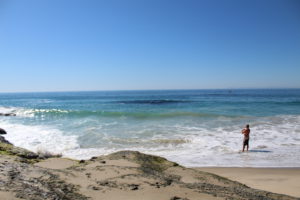
Invest in a good tide book or log. The best logs give a graphic representation of the tide movements. Like a biorhythm chart, the line will move above and below the mean tide line. This allows the reader to conceptualize the high and low tide periods and the range of tide movement in-between. Strong and subtle tides are easily discernible. Additionally, catches and times of catches can be logged into the book, offering valuable insight into the feeding patterns, trends or tendencies of surf zone fish.
For an easily accessible fishery that demands little in the way of tackle and produces excellent surf catches, look to the beach, the grub and the barred surfperch, for a consistent way to have some fast action on just about any Southland beach.

